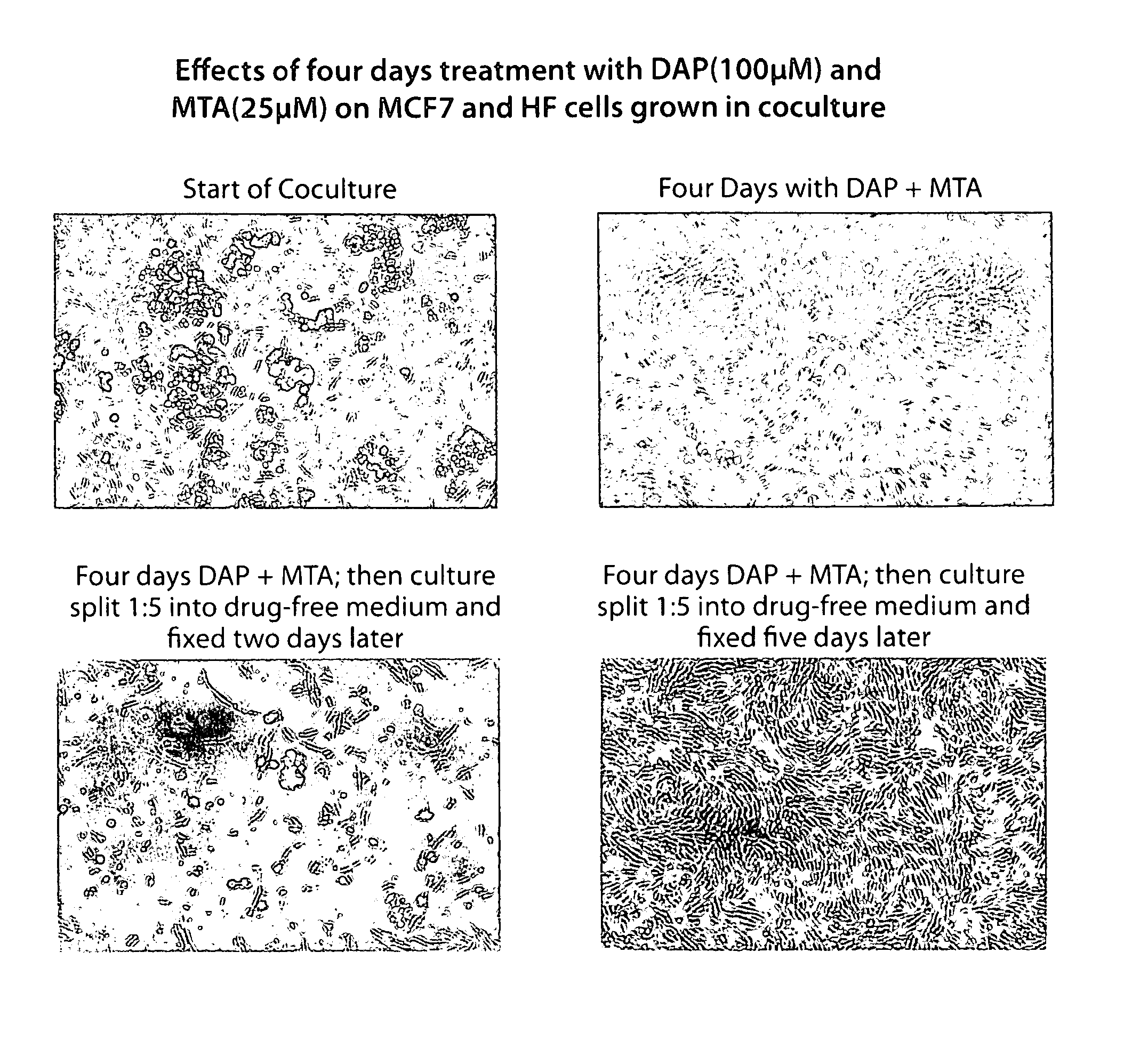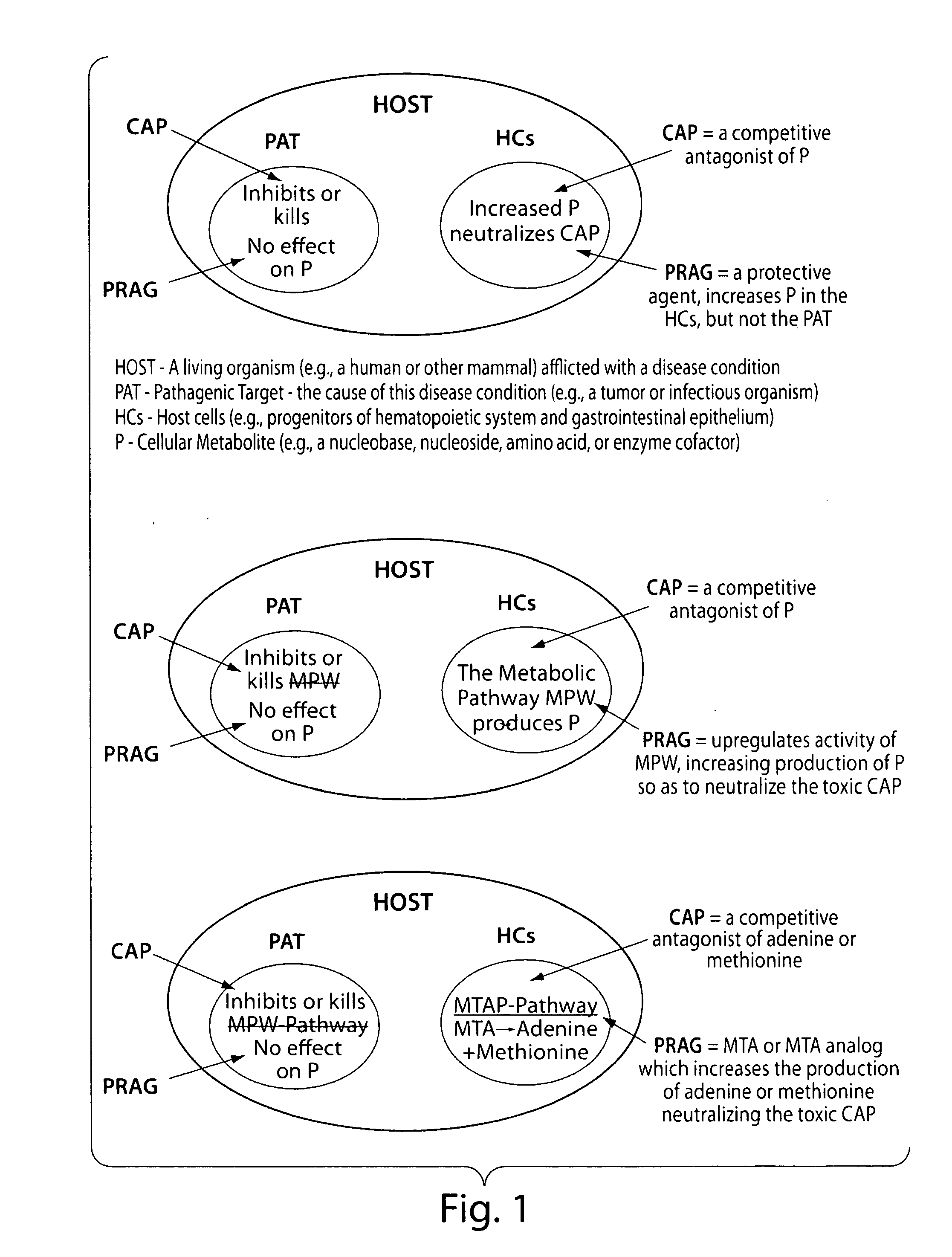Method for the selective therapy of disease
a disease and disease technology, applied in the field of disease treatment, can solve the problems of dividing progenitor cells, toxic effects of antimetabolites, and significant side effects of therapeutic agents, and achieve the effect of increasing the level of cell metabolites and reducing the toxicity of competitive antagonists
- Summary
- Abstract
- Description
- Claims
- Application Information
AI Technical Summary
Benefits of technology
Problems solved by technology
Method used
Image
Examples
example 1
In Coculture, MTA Selectively Protects MTAP(+) HF Cells, but not MTAP(−) MCF7 Cells, from DAP Toxicity
[0220]FIGS. 6A and 6B present photographs of experiments examining the efficacy of the selective therapeutic method of the invention in two human-tissue coculture experiments. In both experiments human fibroblasts (HF cells), which are MTAP-positive, and MCF7 cells, an MTAP-negative human breast adenocarcinoma cell line, were seeded together into culture dishes, in DME supplemented with 10% dialyzed fetal bovine serum.
[0221]In the experiment of FIG. 6A the cell coculture was treated for four days with 100 μM DAP and 25 μM MTA. At the end of this period, some of the culture dishes were fixed, to be photographed. Other dishes were trypsinized and diluted five-fold into fresh (drug-free) medium with adenine added (to stop any further toxic action of DAP) and allowed to grow for two more, or five more, days, before being fixed for photography. A comparison of the photos of the dish fixe...
example 2
In Coculture, 5′-dAdo Selectively Protects MTAP(+) Hf Cells, but not MTAP(−) A549-ouaR Cells, from DAP Toxicity
[0224]HF and A549-ouaR (a ouabain-resistant derivative of the human lung carcinoma cell line A549, isolated by Applicants) cells were cultured together in a medium containing DAP, and with or without 5′-dAdo. After 3 days, cultures were trypsinized and serially diluted into fresh medium for clonogenic assays. Some dishes were treated with 0.1 μM ouabain to kill HF cells and permit easy visualization of surviving A549-ouaR clones. Initial viable cells: HF cells, 11,000; A549-ouaR cells, 40,000.
Results are Shown Below:
[0225]
DAP5′-AdoViable A549-(μM)(μM)Viable HFouaR*125024001257.513,2003*See Methods for limit of detection.
[0226]In coculture, DAP alone effectively killed both HF and A549-ouaR cells, as expected. With the addition of 5′-dAdo, DAP killed A549-ouaR cells, but HF cells were protected by intracellular adenine produced by the action of MTAP on 5′-dAdo.
example 3
5′-dAdo and MTA Both Protect MTAP(+) Hf Cells from MEP Toxicity
[0227]Cell cultures were treated with MeP, with or without 5′-dAdo or MTA, for 4 days. The cell cultures were then changed to fresh medium, with the addition of 30 μM Ade to inhibit further action of the analog. Two days later cultures were trypsinized and a portion of the suspension was counted. Raw data are shown below.
[0228]Initial Coulter counts at start of experiment: 1,157
MeP5′-dAdoMTACoulter(μM)(μM)(μM)counts*00022,5485002,885520025,750501012,407502021,0381020021,993100106,5351002032,078*For total number of cells / dish, multiply by 56.
[0229]MeP was strongly toxic to HF cells. Both 5′-dAdo and MTA effectively protected HF cells against MeP toxicity, and permitted substantial proliferation of these cells.
PUM
| Property | Measurement | Unit |
|---|---|---|
| drug resistance | aaaaa | aaaaa |
| structure | aaaaa | aaaaa |
| size | aaaaa | aaaaa |
Abstract
Description
Claims
Application Information
 Login to View More
Login to View More - R&D
- Intellectual Property
- Life Sciences
- Materials
- Tech Scout
- Unparalleled Data Quality
- Higher Quality Content
- 60% Fewer Hallucinations
Browse by: Latest US Patents, China's latest patents, Technical Efficacy Thesaurus, Application Domain, Technology Topic, Popular Technical Reports.
© 2025 PatSnap. All rights reserved.Legal|Privacy policy|Modern Slavery Act Transparency Statement|Sitemap|About US| Contact US: help@patsnap.com



